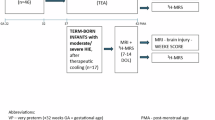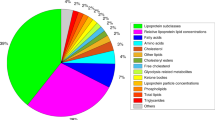Abstract
In this prospective study proton magnetic resonance spectroscopy(1H MRS) was used to test the hypothesis that lactate can be detected later than 1 mo after birth in the brains of infants who display severe neurodevelopmental impairment 1 y after transient perinatal hypoxia-ischemia. Data were obtained from three groups of infants:1) eight infants suffering birth asphyxia followed by perinatal encephalopathy and abnormal neurodevelopmental outcome at 1 y of age (defined as major neurologic impairment, Griffiths quotient <85%, and low optimality score); 2) 10 infants with signs of perinatal hypoxia-ischemia but normal neurodevelopmental outcome at 1 y; and 3) six control infants with uneventful perinatal courses and normal neurodevelopment at 1 y. Between one and four examinations (median 1) were performed at median (range) 11 (4-68) wk after birth, and the cerebral concentration ratio of lactate to creatine plus phosphocreatine (Cr) calculated from each spectrum. Lactate was detected later than the 1st mo after birth in seven of eight infants with abnormal neurodevelopmental outcome [maximum detected lactate/Cr was median (range) 0.44 (0.24-0.67)]. No lactate was detected later than the 1st mo after birth in infants with normal neurodevelopmental outcome, nor in five of six control subjects, although a small amount of lactate was detected in one control infant (lactate/Cr = 0.04). These results suggest that the pathologic postasphyxial process, indicated by persistent cerebral lactate, may not be confined to the period immediately after injury.
Similar content being viewed by others
Log in or create a free account to read this content
Gain free access to this article, as well as selected content from this journal and more on nature.com
or
Abbreviations
- 1 H MRS :
-
proton magnetic resonance spectroscopy
- Cr, :
-
creatine and phosphocreatine
- PCr :
-
phosphocreatine
- P i :
-
inorganic phosphate
- SE :
-
spin-echo
- TE :
-
time to echo
- Cho :
-
choline-containing compounds
- NAA :
-
N-acetylaspartate
- ppm :
-
parts per million
- MRI :
-
magnetic resonance imaging
References
Alberman ED 1982 The epidemiology of congenital defects; a pragmatic approach. In: Adolini M, Benson P, Giannelli A, Seller M (eds) Paediatric Research: A Genetic Approach. Heinemann, London, 1–12.
Kimura H, Fujii Y, Itoh S, Matsuda T, Maeda M, Konishi Y, Ishii Y 1995 Metabolic alterations in the neonate and infant brain during development: evaluation with proton MR spectroscopy. Radiology 194: 483–489.
Hope PL, Costello AM, Cady EB, Delpy DT, Tofts PS, Chu A, Hamilton PA, Reynolds EO, Wilkie DR 1984 Cerebral energy metabolism studied with phosphorus NMR spectroscopy in normal and birth-asphyxiated infants. Lancet 2: 366–370.
Azzopardi D, Wyatt JS, Cady EB, Delpy DT, Baudin J, Stewart AL, Hope PL, Hamilton PA, Reynolds EO 1989 Prognosis of newborn infants with hypoxic-ischemic brain injury assessed by phosphorus magnetic resonance spectroscopy. Pediatr Res 25: 445–451.
Peden CJ, Cowan F, Bryant DJ, Sargentoni J, Cox IJ, Menon DK, Gadian DG, Bell JD, Dubowitz LM 1990 Proton MR spectroscopy of the brain in infants. J Comput Assist Tomogr 14: 886–894.
Peden CJ, Rutherford MA, Sargentoni J, Cox IJ, Bryant DJ, Dubowitz LM 1993 Proton spectroscopy of the neonatal brain following hypoxic-ischaemic injury. Dev Med Child Neurol 35: 502–510.
Groenendaal F, Veenhoven RH, van der Grond J, Jansen GH, Witkamp TD, de Vries LS 1994 Cerebral lactate and N-acetylaspartate/choline ratios in asphyxiated full-term neonates demonstrated in vivo using proton magnetic resonance spectroscopy. Pediatr Res 35: 148–151.
Hanrahan D, Sargentoni J, Azzopardi D, Manji K, Cowan F, Rutherford MA, Cox IJ, Bell JD, Bryant D, Edwards AD 1996 Cerebral metabolism within 18 hours of birth asphyxia: a proton magnetic resonance spectroscopy study. Pediatr Res 39: 584–590.
Roth SC, Edwards AD, Cady EB, Delpy DT, Wyatt JS, Azzopardi D, Baudin J, Townsend J, Stewart AL, Reynolds EOR 1992 Relation between cerebral oxidative metabolism following birth asphyxia and neurodevelopmental outcome and brain growth at one year. Dev Med Child Neurol 34: 285–295.
Rutherford MA, Cowan F, Cox IJ, Sargentoni J, Coutts GA, Bryant DJ 1994 Proton spectroscopy in hypoxic-ischaemic encephalopathy: what is the significance of lactate? Early Hum Dev 36: 225–226.
Groenendaal F, van der Grond J, Witkamp TD, de Vries LS 1995 Proton magnetic resonance spectroscopic imaging in neonatal stroke. Neuropediatrics 26: 243–248.
Sarnat HB, Sarnat MS 1976 Neonatal encephalopathy following fetal distress. A clinical and electroencephalographic study. Arch Neurol 33: 696–705.
Rutherford MA, Pennock JM, Schwieso JE, Cowan F, Dubowitz LM 1995 Hypoxic-ischaemic encephalopathy: early magnetic resonance imaging findings and their evolution. Neuropediatrics 26: 183–191.
Kuenzle C, Baenziger O, Martin E, Thun-Hohenstein L, Steinlin M, Good M, Fanconi S, Boltshauser E, Largo RH 1994 Prognostic value of early MR imaging in term infants with severe perinatal asphyxia. Neuropediatrics 25: 191–200.
Rutherford MA, Pennock JM, Schwieso J, Cowan F, Dubowitz L 1996 Hypoxic-ischaemic encephalopathy: early and late magnetic resonance imaging findings in relation to outcome. Arch Dis Child 75:F145–F151.
Hellstrom Westas L, Rosen I, Svenningsen NW 1995 Predictive value of early continuous amplitude integrated EEG recordings on outcome after severe birth asphyxia in full term infants. Arch Dis Child Fetal Neonatal Ed 72:F34–F38.
Eken P, Toet MC, Groenendaal F, de Vries LS 1995 Predictive value of early neuroimaging, pulsed Doppler and neurophysiology in full term infants with hypoxic-ischaemic encephalopathy. Arch Dis Child Fetal Neonatal Ed 73:F75–F80.
Penrice J, Cady E, Lorek A, Wylezinska M, Amess P, Aldridge R, Stewart A, Wyatt JS, Reynolds EOR 1996 Proton magnetic resonance spectroscopy of the brain in normal preterm and term infants, and early changes after perinatal hypoxia-ischaemia. Pediatr Res 40: 6–14.
Amiel Tison C, Dube R, Garel M, Jequier J C 1983 Outcome at age five years of full term infants with transient neurologic abnormalities. In: Stenn L, Bard H, Friis-Hanson B (eds) Intensive Care in the Newborn. Masson, New York, 247–258.
Cady E 1994 Metabolite concentrations and relaxation in perinatal cerebral hypoxic-ischaemic injury. Neurochem Res 21: 1049–1058.
Leth H, Toft PB, Pryds O, Peitersen B, Lou HC, Henriksen O 1995 Brain lactate in preterm and growth-retarded neonates. Acta Paediatr 84: 495–499.
Pryds O, Greisen G, Lou H, Friis Hansen B 1990 Vasoparalysis associated with brain damage in asphyxiated term infants. J Pediatr 117: 119–125.
Kuroda S, Katsura K, Hillered L, Bates TE, Siesjo BK 1996 Delayed treatment with α-phenyl-n-tert-butyl nitrone(PBN) attenuates secondary mitochondrial dysfunction after transient focal cerebral ischaemia in the rat. Neurobiol Dis 3: 149–157.
Blennow M, Ingvar M, Lagercrantz H, Stone Elander S, Eriksson L, Forssberg H, Ericson K, Flodmark O 1995 Early [18F]FDG positron emission tomography in infants with hypoxic-ischaemic encephalopathy shows hypermetabolism during the postasphyctic period. Acta Paediatr 84: 1289–1295.
Suhonen Polvi H, Kero P, Korvenranta H, Ruotsalainen U, Haaparanta M, Bergman J, Simell O, Wegelius U 1993 Repeated fluorodeoxyglucose positron emission tomography of the brain in infants with suspected hypoxic-ischaemic brain injury. Eur J Nucl Med 20: 759–765.
Rothman DL, Howsman AM, Graham GD, Petroff O, Lantos G, Fayad PB, Brass LM, Shulman GI, Shulman RG, Pritchard JW 1991 Localised proton NMR observation of [3-13C]lactate in stroke after[1-13C]glucose infusion. Magn Reson Med 21: 302–307.
Robertson NJ, Cox IJ, Counsell S, Cowan F, Azzopardi D, Edwards AD 1998 Persistent lactate following perinatal hypoxic-ischaemic encephalopathy and its relationship to energy failure studied by magnetic resonance spectroscopy. Early Hum Dev 5: 73( abstr)
Sims NR 1991 Selective impairment of respiration in mitochondria isolated from brain subregions following transient ischemia in the rat. J Neurochem 56: 1836–1844.
Bates TE, Strangward M, Keelan J, Davey GP, Munro PMG, Clark JB 1996 Inhibition of N-acetylaspartate production: implications for 1H MRS studies in vivo. Neuroreport 7: 1397–1400.
Zaidan E, Sims NR 1993 Selective reductions in the activity of the pyruvate dehydrogenase complex in mitochondria isolated from brain subregions following forebrain ischemia in rats. J Cereb Blood Flow Metab 13: 98–104.
Petroff OA, Graham GD, Blamire AM, al Rayess M, Rothman DL, Fayad PB, Brass LM, Shulman RG, Prichard JW 1992 Spectroscopic imaging of stroke in humans: histopathology correlates of spectral changes. Neurology 42: 1349–1354.
Acknowledgements
The authors thank the members of the neonatal unit, Hammersmith Hospital for their assistance.
Author information
Authors and Affiliations
Additional information
Supported in part by the Medical Research Council, Picker International, and the Garfield Weston Foundation.
Rights and permissions
About this article
Cite this article
Hanrahan, J., Cox, I., Edwards, A. et al. Persistent Increases in Cerebral Lactate Concentration after Birth Asphyxia. Pediatr Res 44, 304–311 (1998). https://doi.org/10.1203/00006450-199809000-00007
Received:
Accepted:
Issue date:
DOI: https://doi.org/10.1203/00006450-199809000-00007
This article is cited by
-
Longitudinal perturbations of plasma nuclear magnetic resonance profiles in neonatal encephalopathy
Pediatric Research (2023)
-
Prognostic MRS in neonatal encephalopathy: closer to generalizability
Pediatric Research (2022)
-
Fifty years of brain imaging in neonatal encephalopathy following perinatal asphyxia
Pediatric Research (2017)
-
Metabolic Alterations in Developing Brain After Injury: Knowns and Unknowns
Neurochemical Research (2015)
-
Magnetic resonance spectroscopy as a prognostic marker in neonatal hypoxic-ischemic encephalopathy: a study protocol for an individual patient data meta-analysis
Systematic Reviews (2013)



